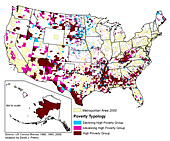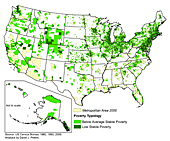AMES, Iowa -- While lawmakers debate what economic stimulus plan will halt the country's spread of new poverty, an Iowa State University sociologist has a new study that reports what communities did between 1980-2000 to reduce poverty.
David Peters, an assistant professor of sociology in Iowa State's College of Agriculture and Life Sciences, says that communities reduced poverty rates by undergoing industrial restructuring, creating new professional jobs and investing in education. His paper, "The Typology of American Poverty," was published in this month's International Regional Science Review 2009. It includes a typology map of the United States that plots areas of high poverty, advancing high poverty and declining high poverty.
"Part of what I was looking at was how industrial restructuring has impacted poverty as small places move away from ag-based economies," Peters said. "So obviously, being in more professional services and those sort of 'new economy' jobs reduces poverty. Being dependent upon agriculture generally increases your chances of being in this poverty group on the national level. What this shows is that manufacturing still provides jobs that are associated with lower rates of poverty."
Midwest historically has low poverty
His research has found that the Midwest has historically had very low poverty, with the exception being Native American reservations in northern Minnesota, northern Wisconsin and the Dakotas. The Upper Midwest -- Iowa, Minnesota, Wisconsin, North Dakota, South Dakota and Nebraska, outside the reservations -- has had very low rates of poverty, according to the study.
"I think the fact that there are no persistent poverty places in Iowa, reflects the high profitability nature of Midwest agriculture, as opposed to less intensive agriculture in the South and the West," Peters said.
The ISU sociologist analyzed data from the U.S. Census Bureau to identify community trajectories of poverty during the 20-year period. The Census Bureau's Persistent Poverty County Codes defines persistently poor counties as those with poverty rates of 20 percent or more among its population each year. Peters broke that data down to more than 40,000 communities across the country, comparing how much a community's poverty rate differed from the national poverty rate.
He says prior research focused on counties rather than communities, making it harder to specifically pinpoint the country's poverty.
"By focusing on counties, if you have a large, wealthy city, it may make those smaller poor communities statistically invisible," he said. "So it's important to look at poverty on a smaller scale. Plus, a lot of what we know about poverty prevention strategies is that they are best done at a local level. So by looking at communities, those communities can come together to address poverty and develop anti-poverty strategies."
Identifying trends in high poverty areas
His analysis found that high poverty and advancing high poverty communities had higher populations of minorities, persons with disabilities and single-headed families -- with higher unemployment rates and lower educational attainment. In terms of the employment structure, they had more employment in agriculture, natural resources and government. By contrast, low poverty places had more jobs in manufacturing and professional or higher-skilled services.
While his study ends with 2000 data, Peters still sees applications today.
"You have to remember that the last data is from the 2000 census, which is at the height of the economic boom," he said. "So even if you had communities that had increasing levels of poverty from 1980 to 1990 and 2000 -- with 2000 at the height of the economic boom -- you can imagine that's probably exacerbated with today's economy being worse than it was in 2000."
For leaders from communities now experiencing high rates of poverty, Peters has some research-based advice.
"One thing would be to diversify the economies, particularly in the types of industries that can't be exported easily. That may mean more personal service jobs that may not be necessarily high paying or glamorous, but they're hard to export," he said. "In terms of the type of all the industries you want to maintain, try to maintain your manufacturing base and your professional services base as much as possible.
"And my paper -- and just about every other paper on poverty -- show returns on investing in education and how it reduces poverty rates on the community level," he continued. "You want to have an educated population to grow your economy to attract residents to your community, as well."
The complete paper is available online at: http://www.soc.iastate.edu/dpeters/pubs/peters-irsr-2009.pdf.

